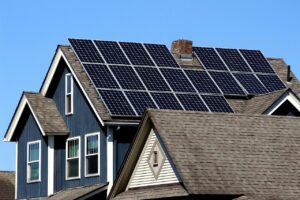Solar energy has emerged as a sustainable and cost-effective solution for homeowners and businesses alike. Beyond its environmental benefits, solar power offers significant savings potential over time.
Here is everything you need to know about solar energy savings potential.
Average Cost of Panels and Installation
The upfront costs of installing a solar system vary widely, ranging from $5,000 for small systems to over $36,000 for large, high-end installations. On average, the cost of solar panels with installation ranges from $6,000 to $20,000 for a 6-kW system, depending on the state.
Additionally, consumers can add solar batteries to their systems, which can store excess energy for use during nighttime, rainy days, or outages. These batteries can cost anywhere from $200 for a single emergency battery to $14,000 for a full lithium-ion system. While optional, solar batteries can offer long-term savings depending on a home’s energy needs.
Solar systems typically require minimal maintenance and can last for approximately 25 to 30 years without significant efficiency loss as long as they are kept clean and undamaged by the elements. Therefore, beyond the initial installation costs, consumers generally do not need to worry about additional expenses until the panels begin to degrade over time.
Tax Breaks and Incentives
While the initial cost of a new solar installation can be substantial, several federal and state rebate programs are available to mitigate the expense. For instance, the Federal Tax Credit for 2022 provides a rebate of up to 26% on the total cost of a new solar setup.
Moreover, the Database of State Incentives for Renewables & Efficiency offers opportunities for consumers to discover state-specific discounts, potentially saving them several thousand dollars on their solar projects.
Savings and Payback Periods for Solar Panel Investments

The typical American household spends around $125 per month on energy bills. By installing a robust solar system that covers your entire energy consumption, you could save up to $1,500 annually.
While immediate savings are evident on your first post-installation power bill, the full extent of your net savings becomes apparent after several years of usage, once the initial panel and installation costs are recouped.
Considering an estimated startup cost of approximately $12,000, factoring in available rebates, it might take around eight years to break even on your solar investment, based on current average energy costs and production figures. However, since solar panels typically maintain efficiency for 25 to 30 years, you’ll still enjoy 17 to 22 years of reduced energy expenses.
An estimated yearly savings of $1,500 translates to potential savings of $25,500 to $33,000 on electricity during your system’s lifespan—assuming energy prices remain stable.
Every household’s energy requirements differ, so your actual savings may vary from the average estimate. Nonetheless, your solar panels are likely to pay for themselves, leaving you with overall savings, all while contributing to the reduction of the environmental impact of fossil fuels.
A Guide to Assessing Your Solar Savings Potential
Here’s a step-by-step approach to estimating your potential savings from solar energy:
- Determine Your Total System Cost: Begin by calculating the overall cost of the solar system, including installation, that meets your energy needs.
- Consider Tax Credits and Incentives: Subtract the Federal Tax Credit and any relevant state incentives available for your solar installation to reduce your initial expenses.
- Evaluate Your Annual Power Bill: Take a close look at your household’s yearly power bill to understand your current energy expenditure.
- Estimate Solar Offset: Estimate the portion of your power bill that your solar system can offset. This calculation should consider your system’s efficiency and the amount of sunlight it receives.
- Calculate Payback Period: Divide the total cost of your solar system (after incentives) by the annual savings on your electricity bills to determine the number of years it will take to “break-even” with your solar investment.